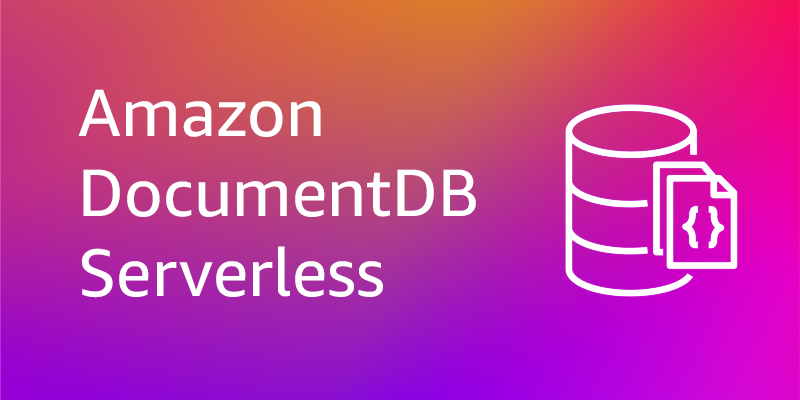|
|
Today we announce the general availability of Amazon DocumentDB Serless, a new configuration for Amazon DocumentDB (with MongoDB compatibility), which automatically scalants calculation and memory based on the demand of your application. Amazon DocumentDB Serless simplifies database management without preliminary obligations or additional costs, offering up to 90 percent of cost savings compared to the provision of top capacity.
With Amazon DocumentDB Serverless, you can use the same compatible and Mongodb capabilities as Amazon DocumentDB, including reading, performance, I/O optimized and integration with other Amazon Web Services (AWS) services.
Amazon DocumentDB Serless presents a new database configuration measured in the DocumentDB (DCU) capacity unit, a combination of approximately 2 GibiBytes (GIB) memory, corresponding to CPUs and networking. It constantly monitors the use of resources such as CPU, memory and network coming from database operations performed by your application.
Amazon DocumentDB Serverless without automatically adjusts DCus up or down to suit the demand without disrupting the availability of the database. Switching from the instances provided to a server without a server in an existing cluster is as simple as adding or changing the type of instance. This transition does not require any data migration. If you want to learn more, see how Amazon DocumentDB Series works.
Some key cases of use and benefits Amazon DocumentDB without server include:
- Variable workload – With Amazon DocumentDB Serless, you can handle sudden trays, such as regular promotional events, development and test environments, and new applications where the use could increase rapidly. You can also create AI AIs applications that benefit from the built -in Amazon DocumentDB vector search and the adaptability without a server to handle the dynamically induced AI Agencies.
- Workload with multiple tenants – You can use Amazon DocumentDB Serless to manage individual database capacity in the entire database fleet. You do not need to manage hundreds or thousands of databases for Enterprises or a multi-multural software environment as a service (SAAS) dealer.
- Workload of mixed use – You can balance reading and writing capacity in workload, which regularly experiences spikes in questioning traffic, such as online transaction processing applications (OLTP). By entering promotional levels for instances without the Amazon DocumentDB server in the cluster, you can configure your cluster so that the reader instance can scale the scale independent of the writer’s instance to handle further loads.
Amazon documentdb instances are more suitable for permanent workload. You can select an instance class that offers predefined amounts of memory, CPU power and I/O bandwidth. If your workload changes when using instances to secure, you should manually adjust the instance class of your writer and readers. Optionally, you can add instances without servers to the Amazon DocumentDB cluster at any time.
Amazon DocumentDB Serverless in Action
If you want to start with the Amazon DocumentDB Serverless, go to the Amazon DocumentDB console. Select in the left navigation pane Clumps and Create.
On Create Amazon DocumentDB cluster Page, select Type of cluster based on instances and then Without server Instance configuration. You can choose the minimum and maximum DCU capacity. Amazon DocumentDB Serless is supported from Amazon DocumentDB 5.0.0 and higher with a capacity range of 0.5–256 DC.

If you use features such as auditing and performance performance, consider adding a DCU for each function. If you want to know more, visit the server scaling without Amazon.
You want to add an instance without a server to an existing cluster, choose Add instance on Action Offer when you select a established cluster. If you use a cluster with an earlier version such as 3.6 or 4.0, you should first upgrade the cluster to the supported version of the engine (5.0).

On Add instance Page, select Without server in Class Instance DB Section for each new instance without the server you want to create. You want to add another instance, select Add an instance And continue to add instances until you have reached the required number of new instances. Choose Create.

You can perform service taking over the failure to create an instance of DocumentDB without The Cluster Writer. You can also convert all the remaining documented instances of Amazon DocumentDB to the DocumentDB instance without a server by changing the instance class or delete them from the Amazon DocumentDB instance deleting.
Now you can connect to the Amazon DocumentDB cluster using the AWS Cloudshell. Choose Join the clusterand you can see the AWS cloudhell Start the command screen. Enter a unique name New name of the environment and choose Create and run.

After prompt, enter the password for Amazon DocumentDB. You are successfully connected to the Amazon DocumentDB cluster and you can start some questions to get acquainted with the use of a document database.

If you want to know more, visit the creation of a cluster that it uses in AWS documentation without Amazon DocumentDB Serverss Serverless without Amazon and manage Amazon DocumentDB Server.
Now available
Amazon DocumentDB Serverless is now available from Amazon DocumentDB 5.0 for new and existing clusters. You only pay a flat rate per second DCU use. If you want to learn more about the details of prices and regional availability, visit the Amazon DocumentDB prices.
Try these new features in Amazon DocumentDB and send AWS Re: Post for Amazon DocumentDB or through the usual AWS support contacts.
– Channels
31/31/2025: Updated screenshot
